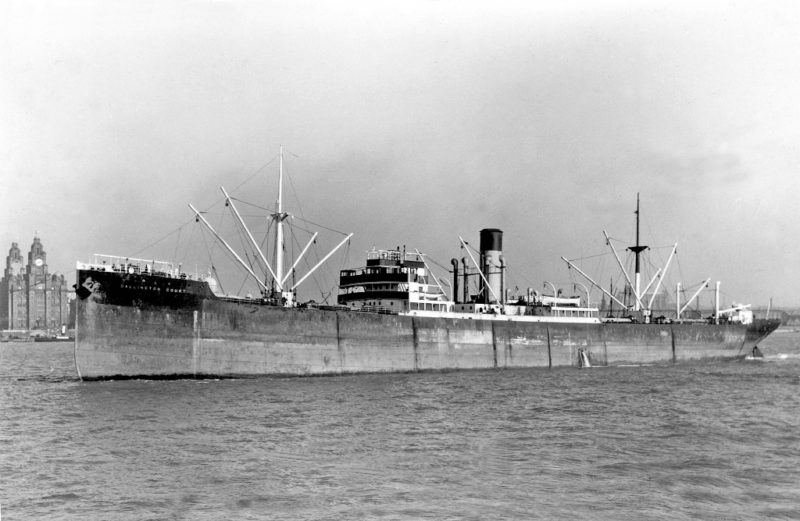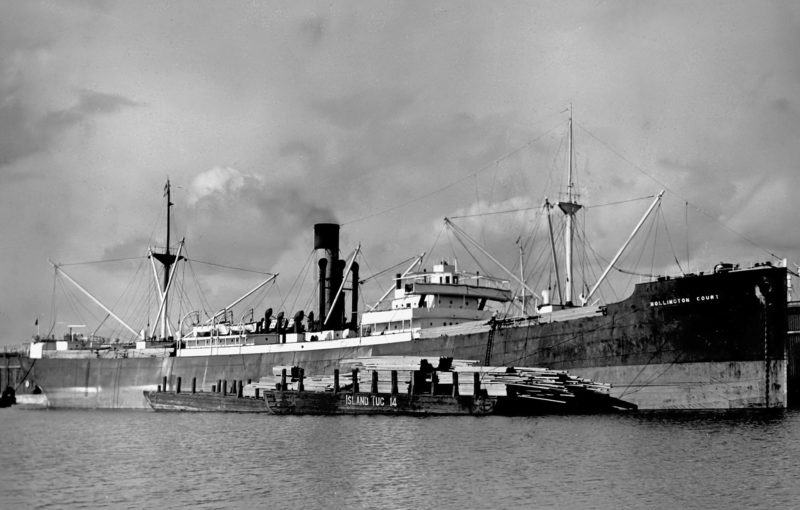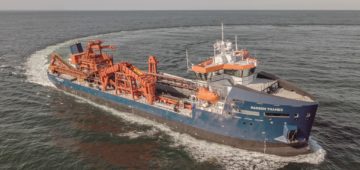
This proud fleet of tramps with their yellow funnels with black tops was started in 1905 by Philip Edward Haldinstein at the age of 25 years, trading at 1, Leadenhall Street, London as Haldinstein & Co. Ltd. His family hailed from Norwich but had a German-sounding name. His first tramp was completed on the Tyne in November of that year by R. Stephenson & Co. Ltd. as Arlington Court and sailed on her maiden voyage under Capt. S.H. Jones. A feature of the nomenclature was the alphabetical choice of English country houses ending in ‘Court’ and including ‘Ing’ in the middle, which although interrupted by WWI was carried down to Wellington Court of 1930. This naming system was restarted again when the fleet was rebuilt after the destruction of WWII.
Freight rates improved after 1908 allowing more new tramps to be ordered, and the letter ‘I’ had been reached by 1913 with Ilvington Court purchased as Dalebank from Dalecrest S.S. Co. Ltd. of London, managed by Harold Taylor and A. Worthington. Arlington Court traded world-wide under Capt. Robert Rooks throughout 1914 when taken on six months time-charter by the German Gans Line to carry cotton from New Orleans and Mobile to Europe. She then loaded coal in the Tyne for Marseilles in early July, and was requisitioned at Cardiff on her return.
Arlington Court was ordered to proceed to Abrolhos Rocks off the coast of Brazil to rendezvous with the South Atlantic fleet under Admiral Craddock. She arrived there on 27th October, but the fleet was far away engaging a German squadron at Coronel off Chile. She waited until 6th November when orders were received to proceed to an anchorage 3 miles outside the English Bank lighthouse in the Plate. Here the loss of the British warships was learnt, and the Hain line tramp Tregurno advised them to move back to Abrolhos to bunker the auxiliary cruiser Orama. The ships were made fast to each other while bunkering was taking place, but the rough sea made them roll heavily with frequent small collisions under water. No leaks were found on the tramp and she set sail for the Falklands to bunker the battlecruiser Invincible, a member of the victorious British squadron at the Battle of the Falk lands.

Arlington Court then came off charter and voyaged to Karachi to load wheat. She was given a 12-pounder as defence against submarines but due to the shortage of these guns it was taken off at Gibraltar and a 3-pounder substituted. Her speed was down to 5.75 knots due to marine growth and when a periscope was sighted travelling along the port side of the tramp only 200 yards away the worst was feared as the 3-pounder could not be depressed sufficiently to take aim. Amazingly no attack was made and Liverpool was safely reached early in 1916. Later that year on 30th October she was chased by a U-boat 50 miles SW of Cape St. Vincent but used her gun to good effect to escape. However she was torpedoed on 14th May 1917 off SW Ireland but was towed in and repaired. She was shortly afterwards sold to the Mitchell Steamship Co. Ltd., London with W.J. Williams as manager and renamed Penylan, a suburb of Cardiff.

Dorington Court of 1908 had been sold in 1913 to P. Gjerding of Bergen and renamed Vally before passing to more famous fellow Norwegians as Romsdalsfjord of Norwegian America Line. She was replaced by a namesake for Court Line Ltd. by a tramp from Richardson, Duck & Co. Ltd. of Stockton in 1915. A backlash against all German sounding names in Britain on the outbreak of war persuaded Philip to shorten his name to the more English-sounding Haldin by Royal Licence on 15th June 1915. His fleet of nine tramps were fortunate in only losing one of their number, the Ilvington Court. She had loaded flour and ammunition at St. John (NB) for Northern France in March 1916. There was no convoy system at this time but she was to be given an escort from 200 miles SW of Ireland. However she mercifully stopped to rescue some 131 survivors from two torpedoed ships, the first of which made her late at the escort picking-up point. This delay probably saved her from destruction as the second ship was torpedoed at the pick-up location. However she was later destroyed when torpedoed and sunk 8 miles WNW of Cape Shershel, 60 miles west of Algiers, while on a voyage from the U.K. to Malta with coal, armour plating and Government stores on 6th December that year and 8 crew were lost.
Subscribe today to read the full article!
Simply click below to subscribe and not only read the full article instantly, but gain unparalleled access to the specialist magazine for shipping enthusiasts.






Comments
Sorry, comments are closed for this item